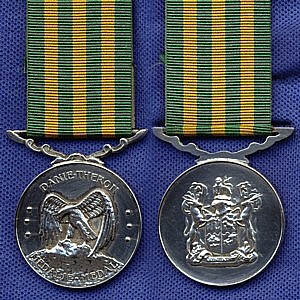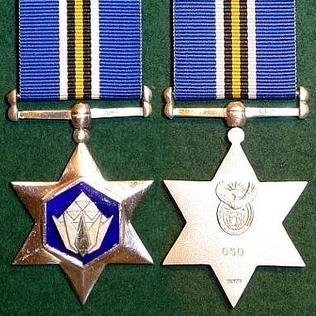
The iPhrothiya yeSiliva - Silver Protea, post-nominal letters PS, was instituted by the President of the Republic of South Africa on 16 April 2003 and came into effect on 27 April 2003. It can be awarded to all ranks who have distinguished themselves by outstanding leadership or outstanding meritorious service and particular devotion to duty. It is South Africa's second highest existing military decoration for meritorious conduct.

The Dekoratie voor Trouwe Dienst, post-nominal letters DTD, is a South African military decoration. It was instituted in 1920 as a retrospective award for Boer officers of the 1899–1902 Second Boer War.
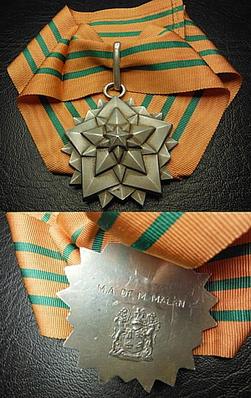
The Star of South Africa, post-nominal letters SSA, is a military decoration for merit which was instituted by the Union of South Africa from 1952 to 1975. It was awarded to general and flag officers of the South African Defence Force for exceptionally meritorious service. The Star of South Africa was discontinued on 1 July 1975, when a new set of orders, decorations and medals was instituted.

The Van Riebeeck Medal, post-nominal letters VRM, is a military decoration for bravery which was instituted by the Union of South Africa in 1952. It was awarded to other ranks for distinguished service in the field.

The Pro Merito Medal of 1967, post-nominal letters PMM, is a military decoration which was instituted by the Republic of South Africa in 1967. It was awarded to other ranks of the South African Defence Force for outstanding devotion to duty and was the non-commissioned officers' version of the Southern Cross Medal of 1952 (SM), which had earlier been available to all ranks.

The Jack Hindon Medal, post-nominal letters JHM, is a South African military decoration which was instituted in the Republic of South Africa in 1970 and which was only in use until 1975. It was awarded to other ranks for diligent service in the Commandos, the rural defence component of the South African Defence Force.
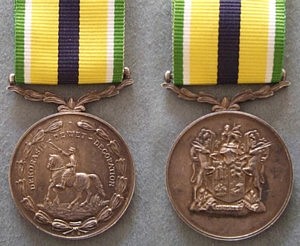
The De Wet Decoration, post-nominal letters DWD, is a military long service decoration which was instituted by the Republic of South Africa in 1965. It could be awarded to members of the Commandos, the rural civil defence component of the South African Defence Force, for twenty years of efficient service and good conduct. The decoration was initially reserved for officers, but it was made available to all ranks in 1986. A clasp could be awarded after thirty years service.

The Military Merit Medal, post-nominal letters MMM, is a military decoration which was instituted in the Republic of South Africa on 9 October 1974 as the Chief of the Defence Force's Commendation Medal. It could be awarded to all ranks of the South African Defence Force for service of a high order.

The Southern Cross Decoration, post-nominal letters SD, is a South African military decoration for merit which was instituted by the Republic on 1 July 1975. It was awarded to officers of the South African Defence Force for outstanding service of the highest order and utmost devotion to duty.

The Pro Merito Decoration, post-nominal letters PMD, is a military decoration for merit which was instituted by the Republic of South Africa on 1 July 1975. It was awarded to other ranks of the South African Defence Force for outstanding service of the highest order and utmost devotion to duty.

The Pro Virtute Decoration, post-nominal letters PVD, is a military decoration for bravery which was instituted by the Republic of South Africa in 1987. It was awarded to officers of the South African Defence Force for distinguished conduct and exceptional leadership during combat operations in the field.

The Southern Cross Medal of 1975, post-nominal letters SM, is a military decoration which was instituted by the Republic of South Africa on 1 July 1975. It was awarded to officers of the South African Defence Force for exceptionally meritorious service and particular devotion to duty.

The National Cadet Bisley Grand Champion Medal is a military medal which was instituted by the Republic of South Africa in 1987. Originally named the Cadet Corps Grand Champion Shot Medal, it was awarded to the Grand Champion of the annual National Cadet Bisley of the School Cadet Corps.

The Pro Merito Medal of 1975, post-nominal letters PMM, is a military decoration which was instituted by the Republic of South Africa on 1 July 1975. It was awarded to other ranks of the South African Defence Force for exceptionally meritorious service and particular devotion to duty, and was the non-commissioned officers' version of the Southern Cross Medal of 1975 (SM).

The Medal for Distinguished Conduct and Loyal Service is a South African military medal which was instituted by the Republic in 1987. It was awarded to members of the South African Defence Force for forty years of loyal service and distinguished conduct.

The De Wet Medal is a military long service medal which was instituted by the Republic of South Africa in 1987. It was awarded to members of the Commandos, the rural defence component of the South African Defence Force, for ten years of efficient service and good conduct.
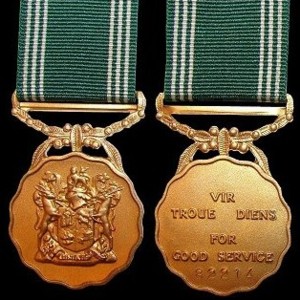
The Good Service Medal, Gold, originally named the South African Defence Force Good Service Medal, Gold, is the senior of a set of three military medals which was instituted by the Republic of South Africa on 1 July 1975. It was initially awarded to members of all elements of the South African Defence Force for thirty years of exemplary service, but was restricted to Permanent Force personnel from 1993.
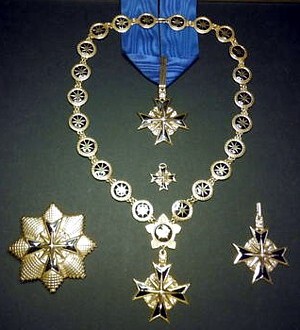
The Star of South Africa, Gold, post-nominal letters SSA, is the senior decoration of two military and five non-military classes of the Order of the Star of South Africa, a South African Order which was instituted in 1975, and awarded to general and flag officers of the South African Defence Force. The Order of the Star of South Africa was discontinued in 2002.

The Marumo Medal, Class I was instituted by the State President of the Republic of Bophuthatswana in 1988.

The Silver Medal for Merit, post-nominal letters SMM, was instituted by the President of the Republic of South Africa in April 1996. It was awarded to veteran cadres of the Azanian People's Liberation Army, the military wing of the Pan Africanist Congress, for exceptionally meritorious service and particular devotion to duty during the "struggle".
